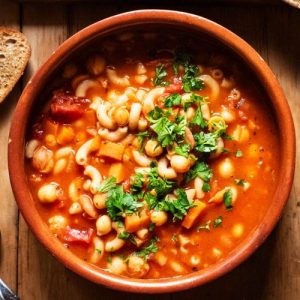
Tomato Pasta Soup
A comforting, quick, and healthy tomato pasta soup loaded with chickpeas, vegetables, and whole grain pasta. Rich in plant-based protein and fiber, this soup is low in saturated fat and perfect for a weeknight dinner or meal prep.
Equipment
- 1 large soup pot
- 1 cutting board
- 1 chef’s knife
- 1 wooden spoon or spatula
- Measuring Spoons
- Measuring cups
Ingredients
- 2 teaspoons oil
- 1 medium onion finely diced
- 1 large carrot finely diced
- 3 cloves garlic minced
- 1 tablespoon tomato paste
- 400 grams 13.5 oz. canned diced tomatoes
- 750 ml 3 cups vegetable broth
- 350 grams 2 cups cooked or canned chickpeas, drained and rinsed
- 1 teaspoon sea salt to taste
- 100 grams 1 ½ cups small whole grain pasta
- 2 teaspoons herbes de Provence or any herb blend
- ½ teaspoon black pepper to taste
Instructions
- Prepare the Vegetables: Start by finely dicing the onion and carrot so they cook evenly and blend smoothly into the soup. Mince the garlic cloves as well—this will release their flavor and aroma during cooking. Having all your vegetables ready before heating the pot ensures a smooth workflow and prevents overcooking any ingredient.
- Heat the Oil: Place a large soup pot over low to medium-low heat and add 2 teaspoons of your chosen oil. Allow the oil to warm gently for about 30 seconds. Heating the oil slowly prevents it from burning and helps the vegetables release their natural sweetness.
- Sauté Onion, Carrot, and Garlic: Add the diced onion and carrot to the pot first, as these take the longest to soften. Stir frequently with a wooden spoon or spatula to avoid browning or sticking. After about 5 minutes, add the minced garlic and continue cooking for an additional 10 minutes, stirring often. You want the mixture to become soft, fragrant, and slightly golden, without letting it burn.
- Incorporate Tomato Paste: Once the vegetables are softened, add 1 tablespoon of tomato paste. Stir it thoroughly into the vegetables, coating them evenly. Cook for 4–5 minutes; this step helps deepen the flavor of the tomatoes and creates a rich base for your soup. The paste may stick to the pot slightly at first, but it will lift as it combines with the other ingredients.
- Add Tomatoes, Broth, and Chickpeas: Pour in 400 grams (13.5 oz.) of canned diced tomatoes and 750 ml (3 cups) of vegetable broth. Then, add 350 grams (2 cups) of cooked or canned chickpeas that have been drained and rinsed well. Sprinkle in 1 teaspoon of sea salt to taste. Stir gently to combine all the ingredients evenly.
- Bring Soup to a Simmer: Cover the pot and increase the heat to medium-high until the soup comes to a gentle boil. Once boiling, immediately reduce the heat to low and allow the soup to simmer, covered, for about 10 minutes. This step allows the flavors to meld together, softens the tomatoes, and ensures the chickpeas are heated through.
- Cook the Pasta: Add 100 grams (1 ½ cups) of small whole grain pasta to the simmering soup. Keep the soup uncovered during this step to prevent it from boiling over. Stir occasionally to prevent the pasta from sticking together or to the bottom of the pot. Cook according to the package instructions, usually 8–10 minutes, until the pasta is tender yet firm. Adjust the heat if the soup isn’t simmering steadily.
- Season with Herbs and Pepper: Once the pasta is cooked, stir in 2 teaspoons of herbes de Provence (or your preferred herb blend) and ½ teaspoon of freshly ground black pepper. Taste the soup and adjust the seasoning, adding more salt or pepper if needed. The herbs add aromatic depth and complement the sweetness of the tomatoes.
- Serve the Soup: Ladle the soup into bowls and serve hot. The mixture should be hearty, with tender pasta, soft vegetables, and flavorful chickpeas in a rich tomato broth. This soup pairs beautifully with crusty bread, a side salad, or a sprinkle of vegan parmesan for added richness.
- Store Leftovers Properly: If you have leftovers, allow the soup to cool slightly before transferring it to an airtight container. Store in the refrigerator for up to three days or freeze for longer-term storage. When reheating, warm gently on the stove to preserve the texture of the pasta and vegetables.
Notes
- For the best flavor, use ripe, high-quality canned tomatoes. They make a big difference in the richness of the soup.
- Whole grain pasta adds fiber and a nutty taste, but you can substitute with gluten-free or regular pasta if preferred.
- Rinse canned chickpeas thoroughly to reduce excess sodium and improve the overall flavor.
- Stir the soup occasionally while cooking the pasta to prevent sticking or clumping.
- Adjust the seasoning at the end, as the flavors develop throughout the cooking process.